Spending too much time on a single phone call is not particularly profitable for businesses. That’s because call tariffs are based on the duration of calls. A large number of high-duration calls can incur businesses a tremendous amount of money.
A short call may not be enough to answer clients’ queries or nurture a new prospect. But indulging in long calls is not a productive move either.
So to optimize the conversational cost and at the same time, provide a good customer experience, the call duration is to be always kept in check.
Recognized by many, average call duration or average call handling time plays an important role in defining the efficiency of a call center. It’s also taken as a metric to measure customer satisfaction and the contact center’s running cost.
Hence, the customer service representative must quickly pick up the phone, respond to the customer, and solve problems even when they’re quite complex.
It doesn’t take long for your customers to become disgruntled if you don’t provide a solution soon after assessing the problem. You can answer fewer calls per day if you take a long time to complete a call.
For this reason, you cannot ignore the average handle time of your call center.
But what is average handling time, how to measure it, and how to reduce average handle time in a call center to ensure excellent customer service? Well, we will explain that in this article, one by one.
What is Average Handle Time?
The average handle time is the amount of time you spent on your phone with your customer. It indicates the time it takes you from start to finish to complete a service call. It includes the hold times, the customer conversation, and any necessary follow-ups.
Call centers often analyze this metric as part of measuring efficiency and one of the most common KPIs. An important KPI to measure in call centers is average handle time, which evaluates the effectiveness of agents, operational efficiency, and productivity.
It is an excellent tool for analyzing everything from the impact of agent training programs to the organization’s process and resources. The customer experience metric is crucial to understanding and improving the customer experience.
It is commonly used for measuring the duration of telephone calls. Businesses can use these metrics by integrating omnichannel support to determine how phone support compares to other channels.
How to calculate Average Handle Time?
Averaging handle time involves the amount of time agents spend on a call and the amount of time they spend on after-call work.
First of all, you’ve to collect data like call time, after-call time, number of calls, and hold time. Once you’ve collected this data, you can easily calculate your average handle time.
Take the sum of your call time, your hold time, and your after-call activities. Taking the sum and dividing it by the number of calls will give you the average handle time.
Depending on the agency, each department or the organization can assess the average handle time.
Also Read: Top Call Center Metrics and KPIs to Measure Your Agent’s Productivity
Factors Affecting Average Handle Time
1. Recurring validations
It is a direct consequence of call transfer. Upon receiving a call from a customer, the first agent verifies it. The second agent will ask the same questions to understand the issue as soon as the call is transferred.
The customer may also become frustrated due to this, increasing your average handle time. You can overcome this problem by using features like a warm call transfer.
2. Time spent on-call transfers
You may be required to transfer inbound customer inquiries to another department from time to time as an agent. If you do this, you will put your customer on hold.
Before transferring the call, you will need to spend a bit of time gathering customer details. As a result of these three factors, the average handle time will increase significantly.
3. Abandoned calls
If you measure agents’ performance using average handle time, you may notice that your agents tend to cut off callers mid-sentence or transfer them to another department. Continuing the conversation may result in the call being handled longer than necessary.
This may be due to the caller being too difficult for them to handle. This will lead to poor customer experience and distortion of your average handle time.
Apart from this, team size, industry, departments, average hold time, after-call time, and repeated calls also affect the average handling time.
How to Reduce Average Handle Time in a Call Center?
Now let’s head to the burning question – how to reduce average handle time in a call center. To answer your query, we have compiled a list of proven tricks that effectively helps to reduce average handle time with much struggle. Using these tips, you can reduce the amount of time it takes to manage each case without affecting the quality of your customer service or harming your business:
1. Train your agents to handle calls
An agent who has been trained optimally will significantly reduce the average handling time at the call center. Average handle time comes down to your agents’ abilities to deal with common issues.
An effective training program requires participants to know what scenarios may be encountered, where to look for relevant information, and who to ask when unsure.
A poorly trained agent may experience fumbling or biding time while searching for solutions on the call. In order to reduce handle time, comprehensive training is a must from the very beginning.
2. Make use of scripts as a guide only
Call handling scripts are only intended to aid agents in handling calls, so make sure your agents are not trained to repeat them. Use it merely as a guide, not as a dialogue script.
When agents focus too much on the scripts, they decrease active listening, which increases overall handling time.
It can also cause agents to ask the same questions repeatedly, frustrating the customer. It would be best to have your agent ask good questions instead of strictly following a script.
3. Enhance internal communication
When aiming to resolve the caller’s issue efficiently, agents sometimes look to their colleagues for assistance.
When you enable internal agent chat, clients will save time spent transferring calls among agents. Your average handle time will improve because your agents can collaborate to get answers faster.
Email won’t cut it when you have a caller on the line and every second counts. A good internal communication system can improve collaboration and decrease the handling time in a call center.
You can accomplish this by using a third-party app or by using the in-built chat feature.
4. Reduce after-call time
It is possible to reduce the average handling time both by reducing talk time and after-call time. However, lowering talk time will not enhance the customer’s satisfaction.
Hence, it would help to reduce the amount of time spent on after-call work (ACW) rather than talking. Automation of after-call tasks like updating contact information and sending transactional emails can dramatically reduce average handle time.
5. Keep track of agent performance
You must ensure your agents are constantly improving their performance, working to decrease handling time, and striving to increase customer satisfaction once they have been set up and running.
When agents are trying to meet their average handle time goals, they can cut off calls early or mark issues as resolved when they aren’t. Although it may be helpful to reduce average handle time, it will also lead to poor customer satisfaction resulting in customer churn.
Hence, it is better to listen to live conversations without an agent knowing than drop into a call to speak to an agent without the caller knowing.
6. Keep a record of all calls
It may take the agents longer to complete a transaction than expected for a variety of reasons. Recalling past calls helps identify and address such issues, so reducing average handle time is impossible without them.
Recorded versions of customer interactions can be used to assess agent productivity and identify inefficiencies. You can listen to call recordings for critical calls when you are unavailable to monitor in real-time.
Identify any inefficiencies or other issues that result in long handling times using the recordings and take action.
7. Improve call routing
The use of call center software with effective call routing can help reduce call handling time by routing calls to the most qualified agent to answer the call.
A wrong agent can also steal time during the initial interaction, thereby increasing your average handle time. In order to ensure that your customers can speak directly with the most qualified agent from the start, you should have a reliable routing system in place.
Thus, less time will be spent on holding and transferring calls, which will reduce your average handle time.
8. Make use of a knowledge base
Knowledge bases are a simple solution for increasing customer satisfaction and decreasing handle time. An agent can quickly access the information that they need using a knowledge base.
In addition to reducing call handling time, access to a knowledge base increases customer satisfaction since callers no longer have to wait on hold while agents search for answers buried in the knowledge base.
Final Thought
It’s important that a call center doesn’t sacrifice the quality of the customer experience to reduce its average handle time. Most customers only contact customer support when they experience an inconvenience in the form of a support interaction, and want a timely and efficient response.
You may always strive to reduce your contact center’s average handle time, but never forget to put quality first contact resolution first. It is best to use the average handle time indicator to minimize those inconveniences instead of merely using it to measure the call center performance.
The top priority of any business should always be excellent customer service. Therefore, when striving to reduce your average handle time, ensure that you do not forget the customer experience.
You can improve customer service and handle customer inquiries with VoIP. And better VoIP services can help you improve both average handle time and customer experience.
KrispCall is one of the VoIP services with features like cloud telephony, sales dialer, IVR, and many more that can help you improve customer experience and average handle time effectively.
Check our pricing plans here. If you want to try it out, you can do that as well. We are offering a free demo and you can use learn more of its features without any initial investment. So KrispCall is worth giving it a try.





